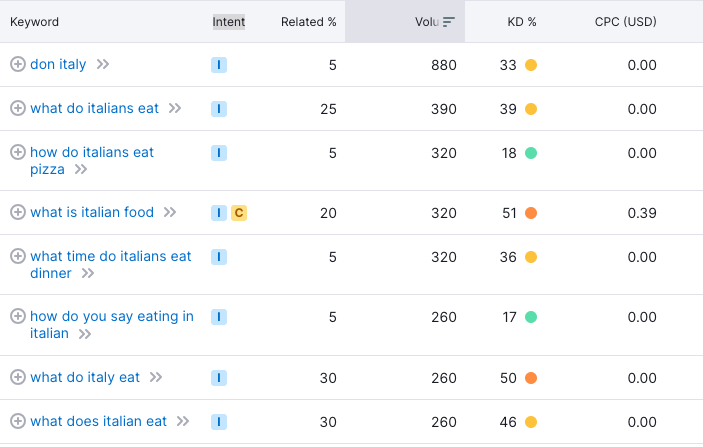Finding Great New Keyword Opportunities

You may think they’re just a fairy tale or urban legend, like Bigfoot, or leprechauns, but believe it or not, there are such things as SEO keywords that offer both low competition and (relatively) high traffic for your specific niche. The hard part, of course, is finding them.
Sometimes called “tangential keywords,” they’ve given rise to an entire branch of search engine optimization called, logically enough, tangential SEO. Let’s take a look at what they are and how to find them.
What are Tangential Keywords?
You’ve probably already figured this out based on their name, but tangential keywords are keywords that are not direct words and phrases relating to your offering, but instead are more obliquely related.
They’re used to target new audiences who are looking for specific solutions or information that are not directly related to your website.
For example, if you’re the webmaster of a site selling European vacations, you may create an article titled “7 Italian Foods You Must Try.” While this content isn’t directly selling your trips, it’s speaking to a peripheral topic while implying that the best place to try authentic risotto alla Milanese is in Milan, and oh by the way, your site just happens to offer a trip there.
While these kinds of keywords don’t offer “top of the sales funnel” awareness, they do serve an important role in building your site’s authority and expertise – plus capture traffic and incoming links you might otherwise miss.
How Do You Find Tangential Keywords?
This, of course, is the million-dollar question: where do you find these elusive peripheral keywords so you can create content utilizing them?
While some people will swear by lists provided by ChatGPT and other AI platforms, at the end of the day, the best way to come up with a list of related topics is to use good old-fashioned brainstorming. So, gather your team, a white board and put on your thinking cap.
The first thing you should do is take a step back from your offering. What are you really selling? What are your targets really looking for?
For example, tanning salons aren’t really selling tans, they’re selling the vibrant feeling of having a deep and healthy tan. They’re selling the glow of eternal summer and an active lifestyle.
Once you’ve identified your raison d’etre, use that as a springboard to discover subtopics that tie into your offering. Write them down, no matter how off-the-wall they may seem – remember there are no wrong answers when you’re brainstorming.
You may find it helpful to create buyer personas. These fictional representatives of your target customer can offer a sense of tangibility that ethereal demographic stats can’t, helping you get inside the mind of the people you’re going after.
Once you have a few terms, start building a mind map. This will allow you to build a hierarchy of your thoughts and establish how they relate to one another.
Once you have a decently sized list of tangential words and phrases, it’s time to harness the power of data.
Open up your keyword research tool of choice and take a look at the volume each query generates. There’s a good chance you’re going to have at least a handful with low, or even no competition. Make those your first priority.
From there, go about creating content as you usually would, whether that means writing blog posts, using AI-generated text or outsourcing to your freelance team.
Why Isn’t Everyone Using Tangential SEO?
As you probably expected, tangential SEO is not all roses and honey – there are experienced SEO professionals who will argue against the use of tangential keywords, pointing at lower conversion rates as a sign of their lack of relevance and/or dilution of your primary message.
As a result, this isn’t a strategy employed by everyone. But that makes it all the more valuable to you.
Key Takeaways
Every SEO professional knows the importance of thinking creatively. Using tangential SEO is merely an extension of this. So long as you’re using a logical, data-driven strategy to find these lower-competition, higher traffic keywords, you’re on the path to establishing yourself as the authority.
Make sure you’re going after key phrases that support your brand’s overall positioning and that they are relevant to the targets you’re going after.
Bonus Tip: Use Influencers & Micro-Influencers
Your target customers likely follow certain influencers on social media, whether they’re major names like Mr. Beast with his 166 million YouTube subscribers or micro-influencers with a *mere* 10,000 followers.
If you have the budget for it, these social media stars can be a great way to build brand recognition and reach. Just be aware that the more followers, the more expensive it’s going to be.
Bonus-Bonus Tip: Use Evisio to Make Everything SEO Easy
Designed to remove the guesswork from SEO and eliminate the tedious tasks associated with search engine optimization (like reporting), Evisio automatically scans your website, then returns a plain English list of actionable steps for fixing issues and capitalizing on opportunities.
Whether you’re an old SEO pro looking for a way to streamline your workflows or a beleaguered entrepreneur trying to optimize a website around a million other tasks, you’ll wonder how you ever got by without it.
But, as they say, the proof is in the pudding, so you should definitely see it for yourself. I’m so sure you’ll love it, that I’m willing to let you try it for free. Contact me today to start your free trial.
If you’re looking for SEO project management software to better manage your workflow, clients, and business – evisio.co is your solution. Try evisio.co for free here!
